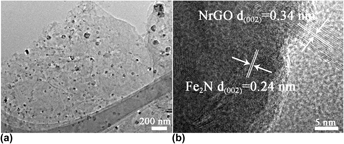Crossref Citations
This article has been cited by the following publications. This list is generated based on data provided by
Crossref.
Chen, Yan-Ru
Wang, Qin
Bai, Xue
Yan, Zhen
Ning, Yunkun
He, Feng
Wu, Zhijian
and
Zhang, Jun
2017.
Unexpected catalytic performance of Fe–M–C (M = N, P, and S) electrocatalysts towards oxygen reduction reaction: surface heteroatoms boost the activity of Fe2M/graphene nanocomposites.
Dalton Transactions,
Vol. 46,
Issue. 48,
p.
16885.
Dong, Zhun
Liu, Guangli
Zhou, Sicong
Zhang, Yanyuan
Zhang, Wanli
Fan, Aixin
Zhang, Xin
and
Dai, Xiaoping
2018.
Restructured Fe−Mn Alloys Encapsulated by N‐doped Carbon Nanotube Catalysts Derived from Bimetallic MOF for Enhanced Oxygen Reduction Reaction.
ChemCatChem,
Vol. 10,
Issue. 23,
p.
5475.
He, Binhong
Kuang, Yafei
Hou, Zhaohui
Zhou, Minjie
and
Chen, Xiaobo
2018.
Enhanced electrocatalytic hydrogen evolution activity of nickel foam by low-temperature-oxidation.
Journal of Materials Research,
Vol. 33,
Issue. 2,
p.
213.
Pi, Mingyu
Yang, Tao
Wang, Shuxia
and
Chen, Shijian
2018.
One-pot synthesis of in situ carbon-decorated Cu3P particles with enhanced electrocatalytic hydrogen evolution performance.
Journal of Materials Research,
Vol. 33,
Issue. 5,
p.
546.
Liu, Hongfei
Guo, Dingyi
Zhang, Wei
and
Cao, Rui
2018.
Co(OH)2 hollow nanoflowers as highly efficient electrocatalysts for oxygen evolution reaction.
Journal of Materials Research,
Vol. 33,
Issue. 5,
p.
568.
Varga, Tamás
Vásárhelyi, Lívia
Ballai, Gergő
Haspel, Henrik
Oszkó, Albert
Kukovecz, Ákos
and
Kónya, Zoltán
2019.
Noble-Metal-Free Iron Nitride/Nitrogen-Doped Graphene Composite for the Oxygen Reduction Reaction.
ACS Omega,
Vol. 4,
Issue. 1,
p.
130.
Fang, Henan
Chen, Junlin
Li, Ying
Peng, Xiang
and
Tao, Zhikuo
2019.
Study of band structure of iron nitrides by angle resolved photoemission spectroscopy.
Journal of Magnetism and Magnetic Materials,
Vol. 475,
Issue. ,
p.
759.
Theerthagiri, Jayaraman
Lee, Seung Jun
Murthy, Arun Prasad
Madhavan, Jagannathan
and
Choi, Myong Yong
2020.
Fundamental aspects and recent advances in transition metal nitrides as electrocatalysts for hydrogen evolution reaction: A review.
Current Opinion in Solid State and Materials Science,
Vol. 24,
Issue. 1,
p.
100805.
Sarno, M.
Ponticorvo, E.
and
Scarpa, D.
2020.
Novel Pt-Ni/NiO/Ni2O3 based electrodes for electrocatalytic biodiesel production from waste palm oil.
Materials Today: Proceedings,
Vol. 20,
Issue. ,
p.
69.
Zhu, Jing
Hu, Liangsheng
Zhao, Pengxiang
Lee, Lawrence Yoon Suk
and
Wong, Kwok-Yin
2020.
Recent Advances in Electrocatalytic Hydrogen Evolution Using Nanoparticles.
Chemical Reviews,
Vol. 120,
Issue. 2,
p.
851.
Chen, Yuerong
and
Jin, Huiming
2020.
Fabrication of amorphous Co–Cr–B and catalytic sodium borohydride hydrolysis for hydrogen generation.
Journal of Materials Research,
Vol. 35,
Issue. 3,
p.
281.
Wu, Yishang
Cai, Jinyan
Xie, Yufang
Niu, Shuwen
Zang, Yipeng
Wu, Shaoyang
Liu, Yun
Lu, Zheng
Fang, Yanyan
Guan, Yong
Zheng, Xusheng
Zhu, Junfa
Liu, Xiaojing
Wang, Gongming
and
Qian, Yitai
2020.
Regulating the Interfacial Electronic Coupling of Fe2N via Orbital Steering for Hydrogen Evolution Catalysis.
Advanced Materials,
Vol. 32,
Issue. 26,
Gubert, Greici
Varalda, José
and
Mosca, Dante H.
2021.
Effect of wavelength and fluence in laser-induced iron nitride nanostructures.
Journal of Alloys and Compounds,
Vol. 856,
Issue. ,
p.
157392.
Upadhyay, Shrish Nath
and
Pakhira, Srimanta
2022.
Photoelectrochemical Hydrogen Generation.
p.
59.
Nguyen, Dinh Chuong
Doan, Thi Luu Luyen
Tran, Duy Thanh
Kim, Nam Hoon
and
Lee, Joong Hee
2022.
Nanomaterials for Electrocatalysis.
p.
49.
Zhang, Changxin
Li, Dan
and
Xu, Yi
2022.
Mn-doped NiP: Facile synthesis and enhanced electrocatalytic activity for hydrogen evolution.
Journal of Materials Research,
Vol. 37,
Issue. 3,
p.
807.
Das, Chandni
Sinha, Nibedita
and
Roy, Poulomi
2022.
Transition Metal Non‐Oxides as Electrocatalysts: Advantages and Challenges.
Small,
Vol. 18,
Issue. 28,
Li, Pengfei
Zhang, Tiezhen
Sun, Haixiao
Gao, Yufeng
Zhang, Yanyuan
Liu, Yuanyuan
Ge, Chengmin
Chen, Hao
Dai, Xiaoping
and
Zhang, Xin
2022.
Cobalt doped Fe-Mn@CNTs catalysts with highly stability for low-temperature selective catalytic reduction of NOx.
Nano Research,
Vol. 15,
Issue. 4,
p.
3001.
Zhang, Jie
Bolle, Bastien
Yin, Shouyi
Bera, Tushar
Wong, Janet S. S.
and
Spikes, Hugh
2024.
Gaseous Lubricity Additives for Hydrogen Gas.
Tribology Transactions,
p.
1.
Patil, Susmita S.
and
Yadav, Jyotiprakash B.
2024.
Electrocatalytic Materials.
p.
273.
